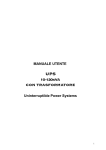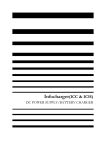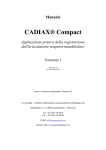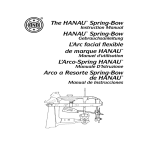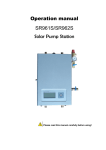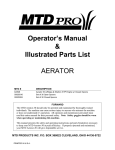Download Pyramiddsp 10-60 kVA user manual
Transcript
Operating and Installation
manual for
PYRAMID DSP
10-60kVA
Uninterruptible Power Systems
511-Y01-U169-1-01
1
Important Notice
Thank you for purchasing Inform UPS.
This document provides instructions about safety, installation and handling of the UPS. It is necessary to
read the manual completely before working on this equipment.
Read the manual completely before working on this equipment!
Keep this manual near UPS for easy consultation!
Symbols
This symbol points out the instructions which are especially important.
This symbol points out the risk of electric shock if the following instruction is not obeyed.
This symbol points out the instructions, which may be resulted with the injury of the operator or
damage of the equipment if not obeyed.
2
511-Y01-U169-1-01
Index
1
Safety ...................................................................................................................................................... 5
2
Installation ............................................................................................................................................. 6
2.1
2.2
2.3
2.4
Transportation ...................................................................................................................................................................6
Unpacking...........................................................................................................................................................................6
Storage.................................................................................................................................................................................6
Placement ...........................................................................................................................................................................6
2.4.1 Environmental Requisites .......................................................................................................................................6
2.4.2 Electrical Requisites..................................................................................................................................................7
2.5 Connections .......................................................................................................................................................................8
2.5.1 Power Connections ..................................................................................................................................................8
2.5.1.1
2.5.1.2
2.5.1.3
2.5.1.4
2.5.1.5
2.5.2
3
Protective Earth (Ground) Connections ................................................................................................................. 9
Input Connection ......................................................................................................................................................... 9
Separated by-pass mains input connection (optional)........................................................................................... 9
External Battery Connection.................................................................................................................................... 10
Output Connection .................................................................................................................................................... 10
Communication Interface Connections..............................................................................................................10
Modes of Operation .............................................................................................................................. 11
3.1
3.2
3.3
4
Bypass Mode ....................................................................................................................................................................12
Normal Mode ..................................................................................................................................................................12
Battery Mode....................................................................................................................................................................13
Control and Monitoring ........................................................................................................................14
4.1
5
Front Panel.......................................................................................................................................................................14
4.1.1 Keypad......................................................................................................................................................................14
4.1.2 Mimic Panel .............................................................................................................................................................15
4.1.3 Liquid Crystal Display (LCD) and User Menu ..................................................................................................16
4.1.4 Buzzer .......................................................................................................................................................................19
Operating Procedures .......................................................................................................................... 20
5.1
5.2
5.3
5.4
5.5
6
Commissioning................................................................................................................................................................20
Decommissioning ...........................................................................................................................................................20
Switching into manual by-pass during operation ......................................................................................................20
Returning from manual bypass to UPS.......................................................................................................................21
Connection to a generator .............................................................................................................................................21
Features and operating limits .............................................................................................................. 22
6.1
6.2
6.3
6.4
6.5
7
Mains limits for normal operation ...............................................................................................................................22
By-pass mains limits for bypass operation..................................................................................................................22
Battery test........................................................................................................................................................................22
Overload behavior ..........................................................................................................................................................22
Electronic short circuit protection ...............................................................................................................................23
Communication.................................................................................................................................... 24
7.1
7.2
7.3
7.4
8
RS232 Communication ..................................................................................................................................................24
RS488 Communication ..................................................................................................................................................24
Digital Inputs (UPS OFF and GEN ON)..................................................................................................................25
Free Contact Communication.......................................................................................................................................25
Maintenance......................................................................................................................................... 26
8.1
8.2
Battery fuses .....................................................................................................................................................................26
Batteries.............................................................................................................................................................................26
511-Y01-U169-1-01
3
8.3
8.4
Fans....................................................................................................................................................................................26
Capacitors .........................................................................................................................................................................26
9
Troubleshooting....................................................................................... Hata! Yer işareti tanımlanmamış.
10
Technical Specifications ...................................................................................................................... 30
4
511-Y01-U169-1-01
1
Safety
Information related to the safety of the UPS, loads and the user is summarized below.
But the equipment should not be installed before reading the manual completely.
The equipment may only be installed and commissioned by authorized technical persons.
When the UPS is brought from a cold place to a warmer place, humidity of the air may
condensate in it. In this case, wait for two hours before beginning with the installation.
Even with no connections have been done, hazardous voltages may exist on connection terminals
and inside the UPS. Do not touch these parts.
Connect the PE ground connector before connecting any other cable.
Do not put the battery fuses into the fuse holder before operating the equipment and seeing the
“NORMAL” message on the LCD.
The connections shall be made with cables of appropriate cross-section in order to prevent the
risk of fire. All cables shall be of insulated type and shall not be laid out on the walking path of
the persons.
Do not expose UPS to rain or liquids in general. Do not introduce any solid objects.
The equipment shall be operated in an environment, which is specified in “placement” section of
this manual.
Affix a label bearing the following expression, on the distribution panels feeding the UPS :
“Isolate the Uninterruptible Power Supply before working on this circuit”
Do not plug the communication cables in or out during stormy weather.
The equipment shall only be maintained and fixed by authorized technical persons.
In case of an extraordinary situation (damaged cabin or connections, penetration of foreign
materials into the cabin etc.) deenergize the UPS immediately and consult to the technical service.
Replaced batteries must be disposed of at authorized waste disposal centers.
Keep this manual near for easy consultation.
The equipment shall be packed properly during transportation.
The equipment is compliant with the European Community directives. Hence it is marked:
511-Y01-U169-1-01
5
2
Installation
2nd1 Transportation
The UPS must remain in a vertical position throughout the transportation.
Make sure that the floor can support the weight of the system.
2nd2 Unpacking
Equipment and batteries whose packages are damaged during transportation shall be inspected by
a qualified technical person before starting with the installation.
The procedure is as following:
Remove the bands and the protective packaging from the UPS.
Use suitable equipment to remove the UPS from the pallet.
Mount the cabinet parts supplied with the UPS after positioning and connecting the UPS.
The equipment shall be packed properly during transportation. Therefore it is recommended to
keep the original package for feature need.
Check if the following are provided with the equipment
Cabinet parts, which are dismounted from the lower part of the UPS cabinet to make handling
with a fork lift easier. (three pieces)
Key of the cabin door
Battery fuses (three pieces)
Test report
2nd3 Storage
Recommended storage temperature, humidity and altitude values are listed on the “Technical
specifications” section.
If the batteries will be stored for longer than 2 months, they shall be charged periodically. Charge period
depends on the storage temperature. The relationship is as shown below:
Every 9 months if the temperature is below 20 °C,
Every 6 months if the temperature is between 20 °C and 30 °C,
Every 3 months if the temperature is between 30 °C and 40 °C,
Every 2 months if the temperature is over 40 °C
2nd4 Placement
2nd4.1 Environmental Requisites
This product meets the safety requirements for devices to be operated in restricted access locations
according to IEC 60950-1 safety standard, which states that the owner should guarantee the following:
6
511-Y01-U169-1-01
Access to the equipment can only be gained by service persons or by users who have been
instructed about the reasons for the restrictions applied to the location and about any precautions
that shall be taken and,
Access is through the use of a tool or lock and key, or other means of security and is controlled
by the authority responsible for the location.
Recommended operating temperature, humidity and altitude values are listed on the “Technical
specifications” section. Air conditioning may be required to provide these values.
Other requisites are:
The equipment and the batteries shall not be exposed to direct sunlight or placed near to a heat
source.
Do not expose UPS to rain or liquids in general. Do not introduce any solid objects.
Avoid dusty environments or areas where dust of conductive or corrosive materials is present.
Air outlets of the UPS are on sides, front and back. Leave at least 75 cm at the front and both
sides and 50 cm at the back for maintenance and ventilation.
2nd4.2 Electrical Requisites
The installation must comply with national installation regulations.
The electrical distribution panels for the mains and separated by-pass mains inputs must have a protection
and disconnection system. Disconnection devices used in these panels shall disconnect all line conductors
and the neutral conductor simultaneously. The following table shows the recommended size of the mains
and separate by-pass mains input protection devices (thermal, magnetic and differential) and the cable
cross-sections for the linear loads.
UPS
[kVA]
10
15
20
30
40
60
Input and bypass mains
input thermal protection
Input and bypass
mains input cable
cross-sections
Battery cable
cross-section
Leakage current
protection*
25 A
32 A
40 A
63 A
80 A
125 A
6 mm2
6 mm2
10 mm2
16 mm2
25 mm2
35 mm2
6 mm2
6 mm2
10 mm2
16 mm2
25 mm2
35 mm2
500 mA
500 mA
500 mA
500 mA
500 mA
500 mA
Input magnetic protection devices shall have D characteristic.
*Load leakage currents are added to those generated by the UPS. If loads with high leakage currents are
present, adjust this value accordingly. It is recommended to adjust the protective device after measuring
the total leakage current with the UPS installed and operational with the intended load.
During transitory phases (power failure, return and voltage fluctuations) short leakage current peaks may
occur. Make sure that the protection is not activated in such cases.
If the loads have a nonlinear characteristic, the current on the mains input, separate by-pass
mains input and output neutral conductors may have a value that is 1.5-2 times the phase value
during operation. In this case, size the neutral cables and the input/output protection adequately.
According to IEC 62040-1-2, the user shall place a warning label on the input distribution panel
and the other primary power isolators, in order to prevent the risk of electric shock caused by a
fault voltage on the UPS. The label shall carry the following wording:
511-Y01-U169-1-01
7
Isolate uninterruptible power supply before working on this circuit
2nd5 Connections
Connections shall be done by authorized technical staff only.
When the UPS is brought from a cold place to a warmer place, humidity of the air may
condensate in it. In this case, wait for two hours before beginning with the installation.
Layout of the connection terminals and boards are shown below:
A1: Communication interface board
A2: Parallel connection board (optional)
F1: Input circuit breaker
F2: Output circuit breaker
F3: Manual by-pass circuit breaker
F4: By-pass circuit breaker (optional)
F5: Battery circuit breaker
F6: Inrush fuse
X1: Battery terminals
X2: Input mains terminals
X3: Separate by-pass mains terminals (optional)
X4: Output terminals
2nd5.1 Power Connections
Devices with internal batteries may have dangerous voltages on the battery terminals
The power screw terminals are located on the lower front side of the UPS. Terminal details are shown in
the figure below. Refer to the names of each terminal to identify it during connection:
8
511-Y01-U169-1-01
Cables shall be passed through the hole under the connection terminals.
Make sure that all circuit breakers are “OFF”/”0” before starting with the installation.
Connections shall be done with the order below.
2nd5.1.1
Protective Earth (Ground) Connections
The device shall be earthed for a safe and reliable operation. Connect the PE ground connectors
before connecting any other cable
Input protective earth connection terminal (PE) of the UPS shall be connected to ground with a low
impedance connection.
PE terminals of the loads shall be connected to output protective earth terminal of the UPS.
If there is an external battery cabin present, it shall be grounded via battery protective earth terminal of
the UPS.
2nd5.1.2
Input Connection
Bring the circuit breaker on the distribution panel to “OFF” or “0” position before making the
connections
Connect the phases to input (X2) L1, L2 and L3 terminals.
A definite phase sequence is needed for the UPS to operate. If you encounter “IN SEQ FLR” alarm at
start up, decommission the UPS, make the protection devices on the input distribution panels “0”/”OFF”
and interchange any two phase cable.
Connect neutral to N terminal of X2.
2nd5.1.3
Separated by-pass mains input connection (optional)
Bring the circuit breaker on the distribution panel to “OFF” or “0” position before making the
connections
Connect the phases to bypass (X3) L1, L2 and L3 terminals.
Make sure that the phases have the same sequence with the input supply.
Connect neutral to N terminal of X3.
511-Y01-U169-1-01
9
2nd5.1.4
External Battery Connection
Do not put the battery fuses into the fuse holder before operating the equipment and seeing the
“NORMAL” message on the LCD.
Devices with internal batteries may have dangerous voltages on the battery terminals
To connect external batteries, do the following:
Switch the circuit breaker of the external batteries to “OFF” or “0” position.
Connect the (-) pole of the external batteries to the battery (-) terminal,
Connect the (+) pole of the external batteries to the battery (+) terminal,
Connect the midpoint of the external batteries to the battery N terminal.
Danger of explosion if the batteries of the wrong type are used.
2nd5.1.5
Output Connection
To enable the short circuit protection feature of the UPS, each load shall be fed over a separate
circuit breaker chosen according to the load current. This may provide quick disconnection of the
short circuited load and operation continuity of the other loads. To obtain maximum protection,
the rating of each individual load circuit breaker shall have the minimum value, which is enough
to carry the full load current continuously.
Rated apparent and active power of the loads shall be less than the UPS power ratings.
Connect the loads to output (X4) L1, L2, L3 and N terminals.
2nd5.2 Communication Interface Connections
Related information is given in “communication” section.
10
511-Y01-U169-1-01
3
Modes of Operation
There are three operation modes, which differ in the path of the energy flow.
UPS block diagrams and the energy flow path in each operation mode is shown below:
When UPS has no separate bypass mains input, bypass line is also fed from the mains input. Thus, if such
a device is in question, mains input shall be comprehended when the bypass mains input is referred in the
following sections of the manual.
UPS behavior at the start-up is different from the usual operation. The UPS can only operate in bypass
mode during start-up. So, in order for the UPS to start-up, frequency/waveform/rms value of the bypass
mains voltage shall be in acceptable limits and bypass shall be enabled.
511-Y01-U169-1-01
11
After start-up, the following applies:
Operation mode depends on the priority, inverter, rectifier and bypass preferences made by the user and
mains, separate by-pass mains and battery voltages.
Priority and inverter, rectifier and bypass preferences can be set by using the COMMANDS and extra
commands (EXTCMNDS) menus.
If operation in any of these modes is impossible, output voltage will not be present. In this case, loads will
not be fed, and “VSECFLR” message is shown on the LCD instead of operation mode.
3rd1 Bypass Mode
In devices without separate bypass mains input, energy is drawn from the mains. In devices with separate
bypass mains input, energy is drawn from the separate bypass mains.
Loads are fed via static bypass line.
Output voltage has the same amplitude, frequency and waveform as the input voltage.
Current drawn by the loads are only limited by the thermal/magnetic switches over the energy flow path.
Voltage, frequency and waveform of the bypass supply shall be in their tolerance limits, and bypass shall
be enabled for the UPS to operate in this mode.
When the upper provisions are met, the UPS works in bypass mode in the following conditions:
During the start-up
If the bypass priority is selected
If the inverter is disabled or blocked
In case of a prolonged overload
You can save energy by selecting the bypass priority. Efficiency in bypass mode is higher than the
efficiency in normal mode. If the bypass priority is selected, the UPS will operate in bypass mode
whenever the frequency/waveform/rms value of bypass mains voltage is in their tolerance limits. If the
bypass voltage goes beyond these limits, the UPS switches into normal operation.
Bypass mode doesn’t provide perfect stability in frequency/waveform/rms value of the output
voltage like in normal mode. Thus, the use of this mode should be carefully executed according to
the level of protection required by the application.
Bypass mode doesn’t provide electronic short circuit protection like in normal mode. If a short
circuit or occurs on the output during bypass operation, the thermal/magnetic protection will act
and all loads will be deenergized.
Prolonged overloads may cause the thermal/magnetic protection act. In this case, all loads will be
deenergized.
3rd2 Normal Mode
Energy is drawn from the mains input.
Loads are fed via the rectifier and the inverter. The AC voltage at the input is converted to a DC voltage
by the rectifier. The inverter converts this DC voltage to an AC voltage with a stable sinusoidal waveform,
amplitude and frequency.
12
511-Y01-U169-1-01
Output voltage is sinusoidal and has a regulated amplitude and frequency. It is independent from the input
voltage.
The inverter is synchronized in frequency with the bypass mains input to enable load transfer to the
bypass supply without any interruption, in case of an overload or inverter failure.
Voltage and frequency of the mains input shall be in their tolerance limits, and both the rectifier and the
inverter shall be enabled for the UPS to operate in this mode.
When the upper provisions are met, the UPS works in normal mode in the following conditions:
If the inverter priority is selected.
If the bypass priority is selected but bypass is disabled or frequency/waveform/rms value of
bypass mains voltage is not in acceptable limits.
3rd3 Battery Mode
Energy is drawn from the batteries. Loads are fed via the inverter.
Output voltage is sinusoidal and has a regulated amplitude and frequency. It is independent from the
battery voltage.
Battery voltage shall be in acceptable limits and the inverter shall be enabled for the UPS to operate in this
mode.
When the upper provisions are met, the UPS works in battery mode in the following conditions:
If rectifier is disabled.
If the rectifier is disabled or frequency/waveform/rms value of mains voltage is not in acceptable
limits.
511-Y01-U169-1-01
13
4
Control and Monitoring
4th1 Front Panel
The front panel located on the upper part of the UPS informs the user about operating status, alarm
conditions and measurements. It also provides access to controls and configuration parameters.
Front panel shown below consists of three parts. As mimic panel provides basic information about the
energy flow path and existing alarms, LCD (liquid crystal display) offers detailed information and provides
access to controls. Keypad enables the user to move in the menu and to make selections.
4th1.1 Keypad
Functions of the buttons are given below:
BUTTON
SYMBOL
DEFINITION
ESC
Exit from the current menu
UP
Scrolls the available menus/values upwards. It increases the
value each time it is pushed when changing a parameter.
DOWN
Scrolls the available menus/values downwards. It decreases the
value each time it is pushed when changing a parameter.
ENTER
Enters the menu displayed on the screen. It makes selections or
confirms the choice/changes made.
14
511-Y01-U169-1-01
4th1.2 Mimic Panel
Mimic panel is a diagram, which shows the path of energy flow in the UPS by means of several LED’s.
Definitions of LED states are shown below:
LED's
ID
COLOR
DEFINITION
Input mains voltage is OK and rectifier is active
Input mains voltage is OK and rectifier is inactive
STATE
Steady
Line 1
Green
Input mains voltage is very close to its upper/lower limit and rectifier is
active
Flashing
Input mains voltage is not OK
Bypass voltage is OK
Bypass voltage is not OK and output voltage is synchronized to the
bypass voltage
Bypass mains voltage is not OK and output voltage is not synchronized
to the bypass voltage
Battery mode is active and battery voltage is OK
UPS is performing battery test and battery voltage is OK
Off
Steady
Line 2
Green
Battery Red
Inverter Green
Load
Green
Bypass
Yellow
Fault
Red
Battery mode is active and battery voltage is close to its lower limit
(energy available in the battery is about to be depleted)
Battery test is active and battery voltage is close to its lower limit
(energy available in the battery is about to be depleted)
Rectifier is active and able to supply whole power required by the
inverter
Load is fed via inverter
Inverter is not active
Load is powered
Load is powered but UPS is overloaded
Output voltage is not OK
Load is fed via static bypass line
Bypass is not active
No alarms
A minor alarm is present
A major alarm is present
511-Y01-U169-1-01
Flashing
Off
Steady
Flashing
Off
Steady
Off
Steady
Flashing
Off
Steady
Off
Off
Flashing
Steady
15
4th1.3 Liquid Crystal Display (LCD) and User Menu
LCD provides detailed information about device status, alarms and measurements. It also enables the
operator to manage the UPS. All information, commands and configuration parameters are given in a
menu, which has the following structure:
LCD consists of two lines and has the following structure:
“OPERATING MODE” or “VSECFLR”
“MENU or PARAMETER NAME”
If there is no voltage on the output, VSECFLR message is displayed on the upper line.
Operation mode parameter is one of the notations below:
NORMAL
BYPASS
BATT
16
OPERATING MODE NOTATIONS
Normal mode
Bypass mode
Battery mode
511-Y01-U169-1-01
Menu and parameter descriptions are given below:
ALARMS MENU
ALR = “XXXXXXXXXXXX”
ST = “XXXX-XXXXXXXX”
12 digit service codes.
Note these numbers before referring technical service.
Alarm codes and names can be seen by entering the ALR submenu.
ALARM DEFINITIONS
CODE NAME
DEFINITION
Bypass mains voltage is different than the inverter reference signal (e.g. its
A01
BYP BAD
frequency is beyond synchronization limits or it has a total harmonic
distortion > %10)
A02
VBYP HIGH
Bypass mains voltage is higher than its upper limit
A03
VBYP LOW
Bypass mains voltage is lower higher than its lower limit
A06
BYP SYN FL
Frequency of bypass mains voltage is beyond the frequency range for bypass
operation or bypass mains voltage is very low
A07
A08
A09
A10
A11
A12
A13
A14
BYP SEQ FL
MAN BYP
INV OVTE
OUT OVLD
INV BLKD
VSEC NOK
VIN HIGH
VIN LOW
Phase sequence of bypass mains voltages is not OK
Manual bypass switch is “ON”
Inverter block temperature is very high
RMS current drawn from any of the output lines exceeds its nominal value
Inverter operation is automatically stopped due to a fault
Output voltage is beyond its limits
Input line/neutral voltage is higher than its upper limit
Input line/neutral voltage is lower than its lower limit
A17
IN SYN FLR
Frequency of mains voltage is beyond the frequency range for normal
operation or mains voltage is very low
A18
A19
A20
A21
IN SEQ FLR
RECT OVTE
RECT OVLD
VDC HIGH
Phase sequence of input mains voltages is not OK
Rectifier block temperature is very high
RMS current drawn from any of the input lines exceeds its nominal value
Any of the DC bus voltages is higher than its upper limit
A22
VDC LOW
Any of the DC bus voltages is lower than its lower limit
Means that the battery is empty during battery operation
A23
A24
A25
RECT BLKD
VDC NOK
AMB OVTE
A26
GEN ON
A27
A28
A29
A30
UPS OFF
BATT FAILED
INV RX FLR
RECT RX FLR
A31
BATT C. OPEN
Rectifier operation is automatically stopped due to a fault
Any of the DC bus voltages approaches its lower or upper limits
Ambient temperature exceeds its upper limit
Generator friendly operation is activated (digital input “GEN ON” is set
high)
Emergency stop is activated (digital input “UPS OFF” is set high)
Batteries failed in the battery test
Communication between the inverter and the front panel is lost
Communication between the rectifier and the front panel is lost
A difference between battery & DC bus voltage is present. Battery circuit
breaker is probably open
All alarms except VSEC NOK are minor.
511-Y01-U169-1-01
17
MEASUREMENTS MENU
MEASUREMENT
LD = XXX,XXX,XXX %
DEFINITION
Ratio of the actual inverter active power of each line to its nominal
value
Vsc = XXX,XXX,XXX V Output line/neutral voltages
Isc
= XXX,XXX,XXX A Output line currents
Fo
= XX.X
Hz Frequency of output line/neutral voltages
Vby = XXX,XXX,XXX V Bypass line/neutral voltages
Vin = XXX,XXX,XXX V Input line/neutral voltages
Iin
= XXX,XXX,XXX A Input line currents
Fin = XX.X
Hz Frequency of input line/neutral voltages
Vdc = XXX,XXX
V Positive and negative DC bus voltages
Vbat = XXX,XXX
V Positive and negative battery branch voltages
Ibat = ±XXX,±XXX
A Positive and negative battery branch currents
Positive during charge, negative during discharge
Tbat = XXX
°C Ambient temperature
COMMANDS MENU
= INVRTR/BYPASS Selects the priority of normal and bypass operation modes
Push ENTER to switch between INVRTR and BYPASS
START B. TEST
Push ENTER to start battery test
Enable or disable the buzzer
BUZZER
= ENBLD/DSBLD
Push ENTER to switch between ENBLD and DSBLD
PRIORITY
COMM
= RS232/RS488
EXTCMNDS
Push ENTER to switch between RS232/RS488
communication
Push ENTER 3 times to enter this submenu
EXTRA COMMANDS SUBMENU
= ENBLD/DSBLD
Enable or disable operation of the rectifier block
Push ENTER to switch between ENBLD and DSBLD
= BLCKD*
Can be seen only when the rectifier is blocked
Push ENTER to remove the blockage and enable the rectifier
= ENBLD/DSBLD
Enable or disable the operation of the inverter block
Push ENTER to switch between ENBLD and DSBLD
= BLCKD*
Can be seen only when the inverter is blocked
Push ENTER to remove the blockage and enable the inverter
= ENBLD/DSBLD
Enable or disable the operation of the bypass thyristors
Push ENTER to switch between ENBLD and DSBLD
RECTFR
INVRTR
BYPASS
* The UPS hinders the operation of the rectifier and inverter blocks in case of a failure.
18
511-Y01-U169-1-01
CONFIGURATION MENU
DATE = "XX-XX-XXXX"
Shows system date in dd-mm-yyyy format
Push ENTER to switch between day, month, year, hour, minute and
second. Then, use arrows to configure
TIME
Shows system time in hh-mm-ss format
Use date submenu to set time
= "XX-XX-XX"
IDENTIFICATION MENU
"X/X XXX kVA"
Shows number of input/output phases and output nominal apparent power
FW
= "XX"
Shows firmware version
4th1.4 Buzzer
Buzzer warns the user about the present alarms. It can be disabled by using the commands menu
BUZZER
STATE
Off
Discontinuous
Steady
DEFINITION
No alarms
A minor alarm is present
A major alarm is present
511-Y01-U169-1-01
19
5
Operating Procedures
This chapter defines the operating procedures to be followed to activate, deactivate and manage the UPS.
The instructions shall be applied with the sequence, in which they are written.
5th1 Commissioning
Make the connections according to the installation section.
Switch the circuit breaker on the input distribution panel “ON” / “I”.
Switch the circuit breaker on the by-pass distribution panel “ON” /”I”.
Bring the inrush fuse (F6) and input fuse (F1) to “ON”/ “I” position.
Bring the by-pass circuit breaker (F4) to “ON”/ “I” position.
Wait for the LCD to start up. Set the date and time.
See the “NORMAL” message on the LCD.
Bring the circuit breaker of the external battery cabinets to “ON”/ “I” position.
Bring the battery circuit breaker (F5) to “ON”/”I” position.
Bring the output circuit breaker (F2) to “ON”/ “I” position.
“NORMAL” message will not be displayed, until the UPS starts up. For the UPS to start-up,
frequency/waveform/rms value of the bypass mains voltage shall be in acceptable limits and
bypass shall be enabled.
5th2 Decommissioning
Bring the output circuit breaker (F2) to “OFF”/”0” position.
Bring the input, inrush and manual by-pass circuit breakers (F1, F6 and F3) to “OFF”/”0” position.
If the by-pass mains input is separated, bring the by-pass circuit breaker (F4) to “OFF”/”0” position.
Bring the battery circuit breaker (F5) to “OFF”/”0” position.
In the event of an extended period of UPS inactivity, the batteries must be charged periodically
in order to prolong battery life. The charge period, which depends on the temperature, is given
in the “storage” section of the manual.
5th3 Switching into manual by-pass during operation
Manual by-pass enables the operator to isolate the electronic circuitry of the UPS from the mains and the
load without interrupting the load operation by connecting the loads directly to the bypass supply. This
feature is useful while performing maintenance or service.
Bring the manual bypass circuit breaker (F3) to “ON”/ “I” position.
Make sure that the UPS switches into bypass operation. (Voltage, frequency and waveform of the bypass
mains shall be in limits, and bypass shall be enabled for the UPS to operate in bypass mode)
Bring the input and inrush circuit breakers (F1 and F6) to “OFF”/”0” position.
If the by-pass mains input is separated, bring the by-pass circuit breaker (F4) to “OFF”/”0” position.
Bring the battery circuit breaker (F5) to “OFF”/”0” position.
20
511-Y01-U169-1-01
5th4 Returning from manual bypass to UPS
If the by-pass mains input is separated, bring the by-pass circuit breaker (F4) to “ON”/ “I” position.
Bring the input and inrush circuit breakers (F1 and F6) to “ON”/ “I” position.
See the “NORMAL” message on the LCD.
Bring the battery circuit breaker (F5) to “ON”/ “I” position.
Bring the manual bypass circuit breaker (F3) “OFF”/”0” position.
5th5 Connection to a generator
If the input power is supplied by a generator, set the digital input “GEN ON” high. This ensures
generator friendly operation by smoothing the increment of the current drawn from the generator, during
transition from battery mode to normal mode.
When this is done, “GEN ON” alarm will be shown.
Connection details are given in the “communication” section.
511-Y01-U169-1-01
21
6
Features and operating limits
6th1 Mains limits for normal operation
Frequency and rms value of the mains input voltage has to be between acceptable limits for the UPS to
operate in normal mode.
Lower limit of the voltage depends on how much the UPS is loaded and it decreases as the load decreases
until it reaches 80 V phase-neutral.
Frequency lower and upper limits and voltage upper limit are fixed.
Voltage and frequency ranges for normal operation are given in the “technical specifications” section of
the manual.
This feature lessens the need to use the batteries. Thus, it increases the battery life and continuity of the
load power.
6th2 By-pass mains limits for bypass operation
Frequency, rms value and total harmonic distortion of the bypass mains input voltage has to be between
acceptable limits for the UPS to operate in bypass mode.
Different rms voltage upper and lower limits are present for the return from another operation mode to
bypass mode. This provides hysteresis and ensures that the device does not change operation mode very
often when the bypass mains rms voltage is close to one of the limits.
Bypass mains limits are software parameters. They can be changed upon request.
6th3 Battery test
This feature enables the user to obtain information about the battery condition. If the batteries have
approached end of their lives, batteries fail.
Battery life depends on several parameters like the number of charge-discharge cycles, discharge depth and
ambient temperature. Battery life greatly decreases as the ambient temperature increases. Therefore it is
recommended to keep the ambient temperature about 20 °C.
To perform a battery test, enter “START B. TEST” in the COMMANDS menu and wait. The UPS will
switch into battery mode, when the test has started. After about ten seconds, UPS will return to the
operation mode before the test. If the batteries pass the test, no alarm will be shown.
If the batteries fail, you’ll receive BATT FAILED message under the ALR submenu. In this case, make
sure that the battery circuit breaker is “ON”/”I”, charge the batteries for minimum 10 hours and repeat
the test. If the alarm persists, consult technical service for replacement.
Make sure that the batteries are fully charged and battery circuit breaker is “ON”/”I” before
starting battery test. Otherwise, the batteries will fail even if they are in good condition.
BATT FAILED message will not disappear until another successful test is performed.
6th4 Overload behavior
While operating in normal or battery mode, the UPS can feed overloads for a limited duration which is
given in the “technical specifications” section. After that duration, UPS automatically switches into bypass
mode, if the bypass is enabled and frequency/waveform/rms value of the bypass mains voltage is
acceptable.
22
511-Y01-U169-1-01
If the overload situation continues in the bypass operation, thermal/magnetic protection devices may
activate and protect the circuit. In this case, all loads on the output will be deenergized.
Make sure that the UPS is not overloaded to provide a higher quality supply to the loads.
6th5 Electronic short circuit protection
The UPS attempts to force the thermal/magnetic protection devices between the output terminals and the
short circuited load to open, by supplying current to the short circuited load for a limited duration. The
UPS shall be working in battery or normal mode, for this feature to work.
To enable the short circuit protection feature of the UPS, each load shall be fed over a separate
circuit breaker chosen according to the load current. This may provide quick disconnection of the
short circuited load and operation continuity of the other loads. To obtain maximum protection,
the rating of each individual load circuit breaker shall have the minimum value, which is enough
to carry the full load current continuously.
If the protection device fails to open the circuit in a limited time, the UPS stops feeding current to the
output. “VSECFLR” message is shown on the upper left of the LCD.
511-Y01-U169-1-01
23
7
Communication
All related terminals are on the communication interface board (A1). Connector layout is as following:
7th1 RS232 Communication
DSUB-9 female connector with the following pin layout shall be used on the UPS side of the connection
cable.
Pin layout is given below:
RS232 PIN LAYOUT
Pin #
Signal Name
Signal Description
2
RX
Receive data
3
TX
Transmit data
5
GND
Signal ground
RS232 cable shall be shielded and shorter than 15 m.
Only one of the RS232/RS488 communications can be activated at one time. The selection between
RS232 and RS488 communications can be done by setting the COMM parameter in COMMANDS menu,
as desired.
7th2 RS488 Communication
DSUB-9 female connector with the following pin layout shall be used on the UPS side of the connection
cable.
Pin layout is given below:
RS488 PIN LAYOUT
Pin #
Signal Name
Signal Description
6
A
Receive signal pair
5
B
1
Z
9
Y
4
GND
Transmit signal pair
Signal ground
RS488 cable shall be shielded and shorter than 100 m.
Only one of the RS232/RS488 communications can be activated at one time. The selection between
RS232 and RS488 communications can be done by setting the COMM parameter in COMMANDS menu,
as desired.
24
511-Y01-U169-1-01
7th3 Digital Inputs (UPS OFF and GEN ON)
Voltage to be applied to the digital inputs is 5V DC. Maximum current drawn by each input is 1 mA.
5V DC supply provided on the communication interface board can be used to supply both digital inputs.
Pay attention to the polarity of the voltages applied to the digital input terminals.
Input
UPS OFF
GEN ON
Function
If the UPS OFF input is set high by applying 5V DC voltage on the related
terminals, UPS stops generating the output voltage and stops feeding the load.
When the voltage on the digital input is removed, the UPS starts up according
to the normal procedure.
If the GEN ON input is set high by applying 5V DC voltage on the related
terminals, UPS smoothly increases the current drawn from the generator
during transitions from battery mode to normal mode.
7th4 Free Contact Communication
Free contact relay connection cables shall have a cross-section of 1.5 mm2.
Maximum voltage to be applied to the relay contacts is 42V AC rms (sinus) or 60 Vdc. Maximum
contact current depends on the applied voltage and the load characteristic. Both maximum
voltage and maximum contact current corresponding to the applied voltage shall not be
exceeded.
Maximum allowed resistive contact currents for several voltages are given on the table below:
Applied voltage
Maximum contact current for resistive load
Up to 42 V AC
16 A
Up to 20 V DC
16 A
30 V DC
6A
40 V DC
2A
50 V DC
1A
60 V DC
0.8 A
Each relay has both a normally open (NO) and a normally closed (NC) contact. One end of these contacts
is common. Normal states of the relay contacts are shown on the figure at the beginning of the
“communications” section.
Relay functions are described below:
Relay
ACFR (AC failure relay)
BYPR (Bypass relay)
BUVR (Battery under voltage relay)
SBFR (secure bus failure relay)
511-Y01-U169-1-01
Function
Contacts change position if the rms value or frequency of the
mains voltage is beyond their limits.
Contacts change position if the UPS is working in the bypass
mode
Contacts change position if the battery voltages are critically low
to feed the load and the load power is about to be interrupted
Contacts change position, if the output voltage disappears
25
8
Maintenance
Batteries, fans and capacitors shall be replaced at the end of their lives.
Hazardous voltage and high temperature metal parts inside even if the UPS is disconnected.
Contact may cause electric shock and burns. All operations except replacing battery fuses shall
be carried out by the authorized technical personnel only.
8th1 Battery fuses
Bringing the battery circuit breaker to “I”/“ON” position before seeing “NORMAL” message on the
LCD may cause battery fuses to blow out.
Battery fuses shall only be replaced with Gould 22x58 aR 660V ultra fast fuse of same rating or
equivalent.
8th2 Batteries
Battery life strongly depends on the ambient temperature. There are also other factors like the number of
charge-discharge cycles and discharge depth.
Battery life is between 3-10 years if the ambient temperature is between 10 – 20 °C. Performing battery
test can provide you information about battery condition. (See “battery test” section for more information
on battery test)
8th3 Fans
The life of fans used to cool the power circuits depends on the usage and environmental conditions.
Preventive replacement by authorized technical personnel every four years is recommended.
8th4 Capacitors
The life of the electrolytic capacitors on the DC bus and the capacitors used for output and input filtering
purposes depends on the usage and environmental conditions.
Preventive replacement by authorized technical personnel every five years is recommended.
26
511-Y01-U169-1-01
9
Troubleshooting
This section gives information about the procedures which shall be performed in case of abnormal
operation. If you fail to fix the problem consult authorized technical service with the following
information:
Model and serial number of the UPS, which can be found on the nameplate on the rear of the
UPS. This information is also available in the test report provided with the UPS.
ALR and ST codes in the ALARMS menu
Hazardous voltage and high temperature metal parts inside even if the UPS is disconnected.
Contact may cause electric shock and burns. This unit is to be served by authorized technical
personnel only.
Alarms and problems you may encounter during operating the UPS are given in the table below.
If you have noticed an abnormality in operation; check the protective earth connections, examine the
circuit breaker positions, read alarms from the ALARMS menu and refer to the table. Apply all
suggestions corresponding to each alarm. If your issue is excluded or the suggested actions do not solve
your problem, consult the technical service.
Alarm
Possible Cause
Bypass mains voltage is different
than the inverter reference signal
BYP BAD alarm is present
(e.g. its beyond its limits or it has a
total harmonic distortion > %10)
VBYP HIGH alarm is
present
VBYP LOW alarm is
present
BYP SYN FL alarm is
present
Action
Make sure that the bypass circuit breaker is
“I"/"ON"(if the UPS has no separate bypass
mains input, make sure that the input circuit
breaker is "I"/"ON".
Bypass mains voltage is higher
than its upper limit
Bypass mains voltage is lower
higher than its lower limit
Check if the bypass mains voltage is in
Frequency of bypass mains voltage specified limits
is beyond the frequency range for
bypass operation or bypass mains
voltage is very low
BYP SEQ FL alarm is
present
Phase sequence of bypass mains
voltages is not OK
Phase sequence of the separate bypass mains
input shall be changed. Consult technical
service
MAN BYP alarm is present
Manual bypass switch is "ON"
Check the position of the manual bypass
switch.
INV OVTE alarm is present
Inverter block temperature is very
high
Check if there is an overload and remove the
excessive load.
Measure the ambient temperature near UPS.
Make sure that the temperature is in specified
limits.
Check if the fans are running.
OUT OVLD alarm is
present
Rms current drawn from any of
the output lines exceeds its
nominal value
Check if there is an overload and remove the
excessive load. If the total power drawn by the
load is less than the nominal power, make sure
that it is distributed evenly between phases.
511-Y01-U169-1-01
27
Alarm
Possible Cause
Inverter operation is automatically
INV BLKD alarm is present
stopped due to a fault
The UPS may not started up yet.
This alarm is permanent if the
UPS is intended to be started with
the bypass blocked or when the
bypass mains is not in specified
limits
VSEC NOK alarm is
present
(Output voltage is beyond
its limits)
The UPS may have stopped to
feed the load because the
combination of the mains
conditions ant the user preferences
made from the COMMANDS
menu does not allow the UPS to
work in any of the operation
modes.(e.g. if inverter is disabled
and both input and bypass mains
voltages are not acceptable or if
the rectifier is disabled when the
bypass voltage is not in specified
limits or batteries may be
discharged during a prolonged
outage)
Action
Consult the technical service
Make sure that all circuit breakers is "I"/"ON"
Check if there is any other alarms and apply the
related suggestions
Examine the preferences, check the mains
voltages and read the "modes of operation"
section of the manual. Determine if the
combination of line voltages and preferences
does inhibit the UPS operation.
The output circuit breaker is
"0"/"OFF"
Input line/neutral voltage is higher
VIN HIGH alarm is present
than its upper limit
Check if the bypass mains voltage is in
Input line/neutral voltage is lower specified limits
VIN LOW alarm is present
than its lower limit
IN SYN FLR alarm is
present
Frequency of mains voltage is
beyond the frequency range for
Check if the mains voltage is in specified limits
normal operation or mains voltage
is very low
IN SEQ FLR alarm is
present
Phase sequence of input mains
voltages is not OK
RECT OVTE alarm is
present
Measure the ambient temperature near UPS.
Rectifier block temperature is very Make sure that the temperature is in specified
high
limits.
Check if the fans are running.
RECT OVLD alarm is
present
RMS current drawn from any of
the input lines exceeds its nominal
value
Check if there is an overload and remove the
excessive load.
VDC HIGH alarm is
present
Any of the DC bus voltages is
higher than its upper limit
Consult the technical service
VDC LOW alarm is present
Any of the DC bus voltages is
lower than its lower limit
Means that the batteries had
discharged. It is removed when the
rectifier resets.
RECT BLKD alarm is
present
28
Phase sequence of the mains input shall be
changed. Consult technical service
If you encounter this alarm during start-up,
check if the inrush circuit breaker is "ON"/"I".
Charge the batteries, perform battery test and
check if the alarm has removed.
Rectifier operation is automatically
Consult the technical service
stopped due to a fault
511-Y01-U169-1-01
Alarm
Possible Cause
Action
Any of the DC bus voltages
approaches its lower or upper
limits
VDC NOK alarm is present
May mean that the batteries have
approached to their lower voltage
limit and are almost empty.
Charge the batteries, and check if the alarm has
removed.
AMB OVTE alarm is
present
Measure the ambient temperature near UPS.
Make sure that the temperature is in specified
limits.
GEN ON alarm is present
UPS OFF alarm is present
BATT FAILED alarm is
present
BATT C. OPEN alarm is
present
(A difference between
battery & DC bus voltage is
present )
Ambient temperature exceeds its
upper limit
Generator friendly operation is
activated (digital input “GEN
ON” is set high)
Emergency stop is activated
(digital input “UPS OFF” is set
high)
Check the "GEN ON" input
Check the "UPS OFF" input
Batteries failed in the battery test
Perform the test again when the batteries have
been charged for a long time and the battery
circuit breaker is "I"/"ON"
Check if the alarm continues
Battery circuit breaker (F5) is
probably open ("0"/"OFF")
Make sure that the battery circuit breaker is
"I"/"ON". If not do the following:
-Check the rectifier preference and enable the
rectifier.
-Make sure that the input mains voltage is in
specified limits.
-Make sure that the UPS has switched to
normal mode and close the battery circuit
breaker.
The battery circuit breaker of the
external battery cabinet is open
("0"/"OFF")
Make sure that the battery circuit breaker of the
external battery cabinet is "I"/"ON". If not do
the following:
-Check the rectifier preference and enable the
rectifier.
-Make sure that the input mains voltage is in
specified limits.
-Make sure that the UPS has switched to
normal mode and close the battery circuit
breaker.
Battery fuses of the battery circuit
Check if the battery fuses are blown. Replace if
breaker (F5) or the external battery
necessary (see maintenance section)
cabinet may have blown
There is no battery in the system
511-Y01-U169-1-01
Batteries shall be supplemented. Consult
technical service
29
10 Technical Specifications
MODELS
Apparent power [kVA]
10
15
20
30
40
60
PHYSICAL
Length x width x depth [cm]
130 x 52 x 90
ENVIRONMENTAL
Storage temperature range [°C]
-25 to +55
Operating temperature range [°C]
0 to +40
(15 - 40 recommended for longer battery
life)
(20 - 25 recommended for longer battery
life)
Relative humidity range
0- % 95 (non condensing)
Max. altitude without derating [m]
1000
Protection level
IP 20
Maximum power
dissipation
[kW]
0,81
1,215
1,28
1,92
2,56
3,84
[Btu]
2,764
4,147
4,369
6,553
8,737
13,106
[kcal/h]
0,696
1,044
1,1
1,65
2,2
3,302
53
79
61
95
ELECTRICAL
Mains Input
Number of phases
3P+N+PE
Nominal voltage [V]
Voltage
range for
normal
operation
(line to
neutral)
[V]
220/380 (line-neutral/line-line)
Lower limit
187 @ %100 load
(depends on the load
level)
120 @ %64 load
80 @ %42 load
Upper limit
280
Nominal frequency [Hz]
50
Frequency range [Hz]
wave form
Nominal
current [A] rms value
45-65
sinusoidal
14
26
23,6
wave form
Maximum
current [A] rms value
40
sinusoidal
16,3
30
27,3
47
Current THD
<%4
Power factor
>0.99
Output
Performance classification according
to IEC 62040-3
VFI-SS-111
Number of phases
3P+N+PE
Nominal voltage [V]
Static
voltage
regulation
normal
@ %100
linear load
battery
220-230/380-400 (line-neutral/line-line)
<%1
Nominal frequency [Hz]
50
Free running frequency [Hz]
50 ± % 0.01
Voltage THD @ rated linear load
Nominal apparent power [kVA]
30
<%3
10
15
20
30
40
60
511-Y01-U169-1-01
Maximum load power factor
0.9
0.8
Nominal active power [kW]
9
13,5
16
24
32
48
Nominal current [A]
16,5
24,8
29,4
45.5
60.6
91
Load crest factor @ rated power
3:1
> 1 minute @ %150 load
> 10 minutes @ %125 load
Overload duration
Efficiency (normal operation)
@rated linear load with 0.8 PF
>91
>92
Static by-pass line
Number of phases
3P+N+PE
Voltage range (line- neutral) [V]*(1)
220 V ±%10
Frequency range [Hz] *(1)
47-53
Nominal apparent power [kVA]
10
15
Nominal current [A]
16,5
24,8
20
30
40
60
29,4
45.5
60.6
91
Transfer duration [ms]
0
Batteries
Battery type
Sealed lead acid, 12 V
Number of batteries
2x31
Nominal battery voltage [V]
2x372
STANDARDS
Safety
EN 50091-1-2
Performance
IEC 62040-3
EMC
EN 50091-2
Product Certification
CE
COMMUNICATIONS
Free contact communication (AC failure, battery under voltage, bypass and output failure)
Serial communications (RS232, RS 488)
Two digital inputs for remote shut down of the UPS and generator operation feedback
Isolated auxiliary 5V supply for digital inputs
OTHERS
Manual by-pass with 0 transfer time
Electronic short circuit protection
Over temperature and over current protection
Liquid crystal display (LCD)
Mimic front panel
*(1) These are software parameters. They can be changed upon request
*(2) Batteries shall be fully charged in order to provide these values
30.03.2006 The manufacturer reserves the rights to change the technical specifications and design without notice.
511-Y01-U169-1-01
31































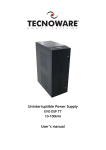
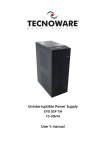
![[ENG] EVO DSP TM 10-30 kVA User Manual v. 2.0](http://vs1.manualzilla.com/store/data/005715238_1-26b73917878f712f842422018d03a475-150x150.png)

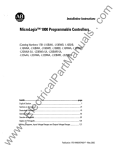



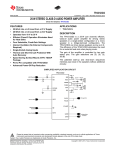
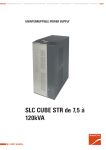
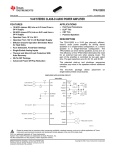


![[ITA] EVO DSP TM 10-30 kVA User Manual v. 2.0](http://vs1.manualzilla.com/store/data/006162882_1-9e3107de6287f10de27272cec5bbb519-150x150.png)
